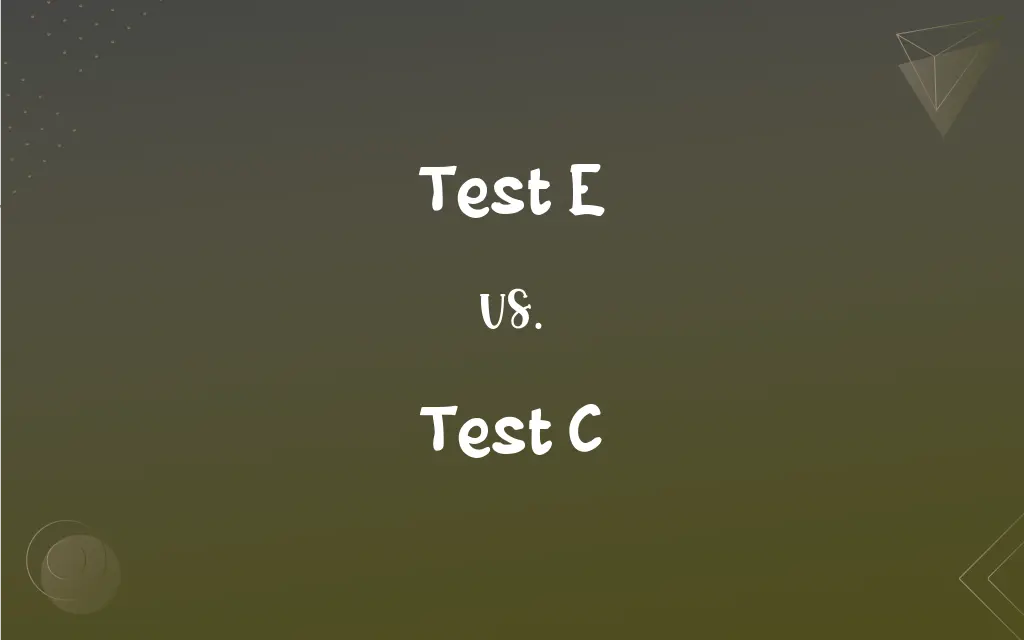Test E vs. Test C: What's the Difference?
Edited by Aimie Carlson || By Janet White || Published on February 23, 2024
Testosterone Enanthate (Test E) and Testosterone Cypionate (Test C) are both synthetic forms of testosterone used for hormone therapy, differing mainly in their ester length and release into the bloodstream.

Key Differences
Testosterone Enanthate (Test E) is a long-acting form of testosterone, often used in testosterone replacement therapy. It has a slightly shorter ester chain than Testosterone Cypionate. This means it releases testosterone slightly faster into the bloodstream after injection. Testosterone Cypionate (Test C), also used in hormone therapy, has a longer ester chain, leading to a slightly slower release of testosterone into the body. Both are administered via intramuscular injections.
The half-life of Testosterone Enanthate is around 7-10 days, which means its effects last about two weeks after injection. Patients using Test E typically have a dosing schedule of once every 1-2 weeks. Testosterone Cypionate has a slightly longer half-life, around 10-12 days, extending its activity in the body. Its dosing schedule is usually once every 1-3 weeks.
Testosterone Enanthate is commonly used in the treatment of hypogonadism in men, providing a steady increase in testosterone levels. It is also used by bodybuilders and athletes to enhance muscle growth and performance. Testosterone Cypionate serves similar purposes but may be preferred in cases where slightly less frequent dosing is desired due to its longer half-life.
Side effects of Testosterone Enanthate and Testosterone Cypionate are similar, as they are both forms of testosterone. They can include acne, hair loss, mood changes, and increased risk of cardiovascular issues. The choice between the two often comes down to patient preference, cost, and dosing convenience.
In terms of availability, Testosterone Enanthate is widely used and available in many countries, including in Europe. Testosterone Cypionate is predominantly used in the United States. Both require a prescription and should be used under the supervision of a healthcare provider.
ADVERTISEMENT
Comparison Chart
Ester Chain Length
Slightly shorter ester chain
Longer ester chain
Release Rate
Slightly faster release into bloodstream
Slower release into bloodstream
Half-Life
7-10 days
10-12 days
Common Use
Hormone therapy, bodybuilding
Hormone therapy, bodybuilding
Availability
Widely available globally
Predominantly used in the USA
ADVERTISEMENT
Test E and Test C Definitions
Test E
A long-acting form of testosterone with a shorter ester.
The doctor prescribed Test E for the patient's hormone therapy.
Test C
Preferred for its slightly slower testosterone release.
Doctors often recommend Test C for its sustained release profile.
Test E
Used for testosterone replacement and muscle building.
Bodybuilders often use Test E for its muscle-enhancing effects.
Test C
A synthetic testosterone with a longer-lasting ester.
Test C is her prescribed medication for testosterone therapy.
Test E
Widely available synthetic testosterone variant.
Test E is a popular choice in testosterone therapies worldwide.
Test C
Predominantly used in the United States for hormone replacement.
In the U.S., Test C is a common choice for testosterone replacement therapy.
Test E
Injected typically every 1-2 weeks due to its half-life.
His Test E injection schedule is once every fortnight.
Test C
Treats hypogonadism and is used in bodybuilding.
Test C helps him maintain stable testosterone levels for muscle growth.
Test E
Provides steady testosterone levels for hypogonadism treatment.
Test E effectively managed his low testosterone symptoms.
Test C
Used in hormone therapy with a dosing schedule of 1-3 weeks.
He receives Test C injections every three weeks.
FAQs
What are common side effects of Test E?
Acne, hair loss, mood swings, and increased risk of heart disease.
How long does Test E stay in the system?
Its half-life is about 7-10 days.
How often should Test E be administered?
Typically, injections are every 1-2 weeks, but it varies based on individual needs.
Can Test E cause liver damage?
It's less likely than oral steroids, but risks increase with abuse.
What is Testosterone Enanthate (Test E)?
A synthetic form of testosterone used in testosterone replacement therapy and bodybuilding.
What are the main uses of Test E?
Treating low testosterone levels and as a performance-enhancing drug.
What are the benefits of using Test C?
It helps in muscle growth, fat loss, and improving recovery time.
How is Test E administered?
It's usually injected intramuscularly.
What is the half-life of Test C?
Approximately 8-12 days.
Can Test E be used by women?
Rarely, and under strict medical supervision due to potential virilizing effects.
Is a prescription required for Test E?
Yes, in most countries it's controlled and requires a prescription.
How is Test C different from Test E?
The difference lies in their ester length; Test C has a slightly longer half-life.
Can Test C improve athletic performance?
It can increase muscle mass and strength, but is banned in most sports.
How does Test C interact with other medications?
It can interact with blood thinners, diabetes medication, and others, requiring medical consultation.
Does Test E affect mood?
It can cause mood swings and aggression, especially in high doses.
What is Testosterone Cypionate (Test C)?
Another synthetic form of testosterone, similar to Test E, used for similar purposes.
How is Test C dosage determined?
Dosage is based on individual therapeutic needs and medical advice.
Can Test C be used in hormone therapy for transgender men?
Yes, it's one of the options for masculinizing hormone therapy.
What are the legal implications of using Test C?
Without a prescription, it's illegal in many regions and can result in legal consequences.
Are there any cardiovascular risks associated with Test C?
Yes, like other steroids, it may increase the risk of heart disease.
About Author
Written by
Janet WhiteJanet White has been an esteemed writer and blogger for Difference Wiki. Holding a Master's degree in Science and Medical Journalism from the prestigious Boston University, she has consistently demonstrated her expertise and passion for her field. When she's not immersed in her work, Janet relishes her time exercising, delving into a good book, and cherishing moments with friends and family.
Edited by
Aimie CarlsonAimie Carlson, holding a master's degree in English literature, is a fervent English language enthusiast. She lends her writing talents to Difference Wiki, a prominent website that specializes in comparisons, offering readers insightful analyses that both captivate and inform.







































































